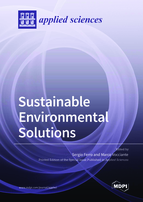Sustainable Environmental Solutions
A special issue of Applied Sciences (ISSN 2076-3417). This special issue belongs to the section "Environmental Sciences".
Deadline for manuscript submissions: closed (31 December 2020) | Viewed by 59220
Special Issue Editors
Interests: Dimensionally Stable Anodes (DSA®) for oxygen and chlorine production; environmental applications of electrochemistry; environmental remediation; water & soil treatments; electrolysed water
Special Issues, Collections and Topics in MDPI journals
Interests: environmental remediation; water and soil treatments; environmental nanotechnology; resource recovery; process modelling and simulation
Special Issues, Collections and Topics in MDPI journals
Special Issue Information
Dear Colleagues,
The continuous development of our society has led to a steady growth of problems related to environmental pollution. Unfortunately, due to numerous socioeconomic reasons, the development of technologies able to remedy the damage caused by human activities has not been so rapid.
In recent decades, increasing attention has been given to the sustainability of products and processes. This also applies to activities aimed at environmental protection, site reclamation or treatment of contaminated effluents, as well as the valorisation of waste through the recovery of resources. Although implemented with “noble intentions”, these activities are often highly invasive, unsustainable, and socially unacceptable, as they involve a significant use of chemical products or processes.
This Special Issue aims at collecting research activities focused on the development of new processes to replace the above-cited obsolete practices. Taking inspiration from real problems and the need to face real cases of contamination or prevent potentially harmful situations, we discuss the development and optimisation of “smart” solutions, i.e., sustainable not only from an environmental point of view, but also economically, in order to encourage as much as possible their actual implementation.
Contributions on the following topics are particularly welcome:
- Energy and water efficiency in industry and mining (construction materials; food industry; metallurgy; chemical industry; process optimisation; water use and waste minimisation; life cycle assessment; cleaner production; environmental impact assessment);
- Renewable energy resources (technical and economic potentials; barriers; cost and benefits);
- Nano/microtechnologies and science for sustainable development of energy, water, and environment systems;
- Environmental management (waste management; wastewater management; climate change mitigation; climate change adaptation; land management; reclamation and rewilding; social aspects; strategic environmental impact assessment);
- Modelling for pollution avoidance, energy efficiency and resources optimisation (computer-aided engineering; pollution spreading; heat and mass transfer modelling).
Dr. Marco Vocciante
Guest Editors
Manuscript Submission Information
Manuscripts should be submitted online at www.mdpi.com by registering and logging in to this website. Once you are registered, click here to go to the submission form. Manuscripts can be submitted until the deadline. All submissions that pass pre-check are peer-reviewed. Accepted papers will be published continuously in the journal (as soon as accepted) and will be listed together on the special issue website. Research articles, review articles as well as short communications are invited. For planned papers, a title and short abstract (about 100 words) can be sent to the Editorial Office for announcement on this website.
Submitted manuscripts should not have been published previously, nor be under consideration for publication elsewhere (except conference proceedings papers). All manuscripts are thoroughly refereed through a single-blind peer-review process. A guide for authors and other relevant information for submission of manuscripts is available on the Instructions for Authors page. Applied Sciences is an international peer-reviewed open access semimonthly journal published by MDPI.
Please visit the Instructions for Authors page before submitting a manuscript. The Article Processing Charge (APC) for publication in this open access journal is 2400 CHF (Swiss Francs). Submitted papers should be well formatted and use good English. Authors may use MDPI's English editing service prior to publication or during author revisions.
Keywords
- Environmental pollution and remediation
- Resource recovery and recycling strategies
- Sustainability assessment
- Hazardous waste management
- Water and wastewater treatment
- Waste recovery, recycling and valorisation
- Soil and water reclamation
- Valorisation of waste-streams
- Emerging contaminants
- Nanomaterials
- Process modelling







